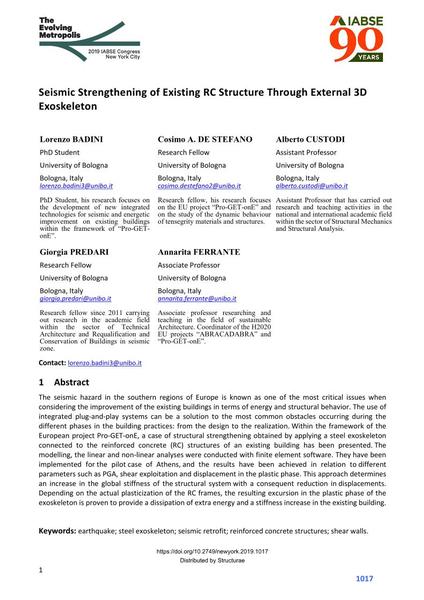Seismic Strengthening of Existing RC Structure Through External 3D Exoskeleton

|
|
|||||||||||
Détails bibliographiques
| Auteur(s): |
Lorenzo Badini
(University of Bologna)
Cosimo A. de Stefano (University of Bologna) Alberto Custodi (University of Bologna) |
||||
|---|---|---|---|---|---|
| Médium: | papier de conférence | ||||
| Langue(s): | anglais | ||||
| Conférence: | IABSE Congress: The Evolving Metropolis, New York, NY, USA, 4-6 September 2019 | ||||
| Publié dans: | The Evolving Metropolis | ||||
|
|||||
| Page(s): | 1017-1023 | ||||
| Nombre total de pages (du PDF): | 7 | ||||
| DOI: | 10.2749/newyork.2019.1017 | ||||
| Abstrait: |
The seismic hazard in the southern regions of Europe is known as one of the most critical issues when considering the improvement of the existing buildings in terms of energy and structural behavior. The use of integrated plug-and-play systems can be a solution to the most common obstacles occurring during the different phases in the building practices: from the design to the realization. Within the framework of the European project Pro-GET-onE, a case of structural strengthening obtained by applying a steel exoskeleton connected to the reinforced concrete (RC) structures of an existing building has been presented. The modelling, the linear and non-linear analyses were conducted with finite element software. They have been implemented for the pilot case of Athens, and the results have been achieved in relation to different parameters such as PGA, shear exploitation and displacement in the plastic phase. This approach determines an increase in the global stiffness of the structural system with a consequent reduction in displacements. Depending on the actual plasticization of the RC frames, the resulting excursion in the plastic phase of the exoskeleton is proven to provide a dissipation of extra energy and a stiffness increase in the existing building. |
||||
| Mots-clé: |
tremblement de terre reconception pour effets sismiques
|
||||
